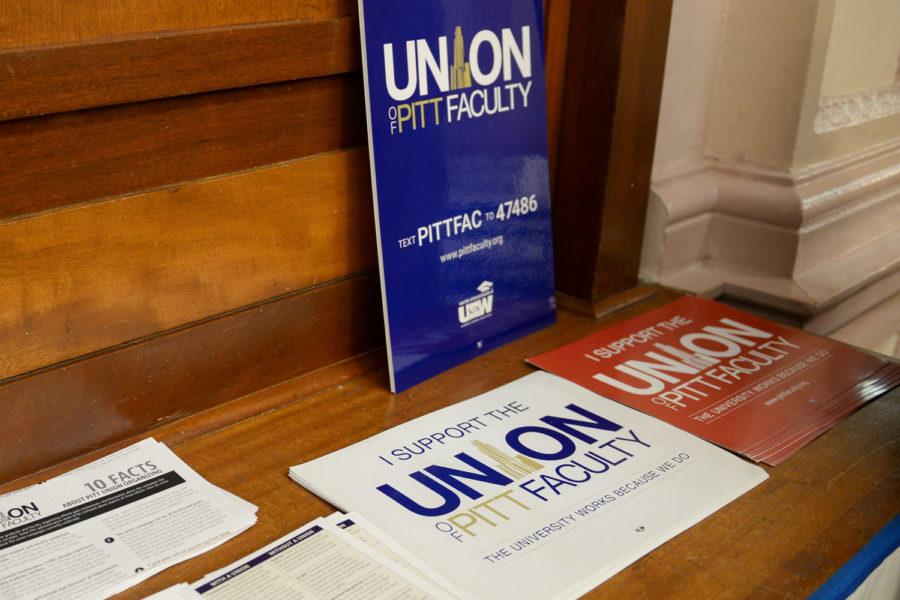‘A long time coming’: Pitt faculty celebrate union victory
Pitt faculty voted to unionize, creating the largest new union in the country. Chris Deluzio, an adjunct law school professor, said he’s “ecstatic” about the “huge win.”
October 22, 2021
When Pitt faculty voted against unionization in 1991, then United Faculty President Philip Wion wasn’t sure he’d ever see the University’s professors and researchers form a union. Now 80 years old and retired from teaching, he watched Tuesday as a younger generation of faculty achieved what he had worked for decades earlier.
“It was really thrilling to see the news,” Wion, a professor emeritus, said after the Pennsylvania Labor Relations Board announced Tuesday that Pitt faculty had voted to unionize in a landslide. According to the labor board’s election returns document, 1,511 faculty, or 71%, voted in favor of joining the United Steelworkers and 612, or 29%, voted against it.
With more than 3,000 people represented, Pitt faculty created the largest new union of any kind in the country this year, organizers said, ushering in a new era of faculty-administration relations at the University.
Dozens of Pitt faculty — both organizers and ordinary supporters — gathered at the United Steelworkers headquarters Wednesday evening Downtown to celebrate their victory and reflect on the yearslong campaign.
Chris Deluzio, an adjunct at the law school and a candidate for Pennsylvania’s 17th Congressional district, said he’s “ecstatic” about the election result. Deluzio was not eligible to vote in the election, but has voiced his support for the effort many times.
“It’s a huge win, not just for us as faculty, but for the University [and] our students,” Deluzio said. “It sends a huge message to workers in Western Pennsylvania that labor is not on defense anymore.”
For more than five years, Pitt’s organizing team and the United Steelworkers — an international union with more than 800,000 members — have been knocking on faculty office doors to tell their colleagues about how a union could improve their lives. Organizers have focused on a range of issues, from pay to job security to shared governance.
Paul Johnson, an assistant professor of communications, said “years of conversations” helped bring about the victory.
“What made it possible was the faculty,” Johnson said. “A lot of faculty had some issues with how their job at the University was, and they wanted to do something about it.”
The campaign has especially resonated with adjunct faculty, who often make about $4,000 per course and have very little say in University operations.
Melinda Ciccocioppo, a psychology lecturer, said she started her career as an adjunct, sometimes teaching five courses per semester across three different universities and making little more than $20,000 a year. Feeling frustrated and overworked, she started talking to her colleagues at Pitt about a union.
“I started hearing my story over and over again,” Ciccocioppo said. “I started hearing about the precariousness of people’s positions, about the fact that they weren’t making the money they needed to make to survive.”
Jeff Shook, an associate professor in the School of Social Work, said he organized for a union in part to help adjuncts.
“We have a lot of adjunct faculty, so the more we can do to improve their ability to do their jobs, the better experience our students will have,” Shook said.
For Shook, the benefits of organizing a union didn’t come only from the end result. He said faculty across all departments have been able to bond over shared issues.
“All over the University, we’ve gotten to know each other instead of being in our silos,” Shook said. “I think it opens up teaching ideas, class ideas, research collaboration, ways to involve students that we wouldn’t have without those kinds of conversations.”
With a faculty union now established at Pitt, faculty collaboration will continue. To set the union in motion, faculty will elect a bargaining committee with representatives from each department — aside from the School of Medicine, which was excluded from the union — to negotiate a contract with the administration. Once they agree on a contract, Pitt faculty must vote to approve it, a representative from United Steelworkers said.
“I cannot wait to sit down with administration and negotiate,” Ciccocioppo said.
During that process, anthropology professor Tomas Matza said, organizers will reach out to faculty who voted “no” on unionizing, and try to understand their concerns.
“The spirit of our union has to be that we represent all perspectives and points of view of faculty at the University,” Matza said. “There will be plenty of opportunities for people who had hesitancy or reluctance to voice their opinions.”
Throughout the campaign, the University administration has not explicitly come out against faculty unionization. But many faculty and students have criticized the University for spending more than $2 million on “union avoidance” law firm Ballard Spahr since the union campaign began in 2016.
“I was disappointed the way that the administration decided to use resources to make it harder for us to form a union,” Johnson said.
Despite the lopsided election result, the victory did not come easily for union organizers. The University’s faculty have tried and failed to unionize three times before. The first effort, in 1976, fell short of a majority in a run-off election. The second, in 1991, failed when faculty voted against unionization 1,243-719. And most recently, in 1996, faculty organizers pulled their petition for an election, suspecting they wouldn’t receive a majority vote.
Wion was at Pitt for all three of those efforts. He said the University hired anti-union law firms and tried to divide faculty by rank and department.
“It was hard to get people to feel solidarity, to feel that we’re in this together,” Wion said. “This time around, faculty at Pitt were ready for reform.”
Now that Pitt faculty have a union, Wion and Shook said all the years of advocacy have been worth it.
“It was a long time coming,” Shook said.
Punya Bhasin contributed reporting.



